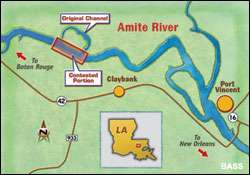
BATON ROUGE, La.— The fight to maintain public access to Louisiana's fisheries received a boost in late December when the State Attorney General's office ruled that gating "running waters" is illegal under state law, even if the water in question is flowing through man-made canals that have replaced natural river channels.
"It is our opinion that the law does not support the gating of a river in Louisiana," stated Assistant Attorney General Ryan Seidemann in a written opinion.
"Such an action is contrary to the concept that the waterways of this state are highways of commerce and recreation."
The opinion came in response to a permit application by a private landowner along the Amite River south of Baton Rouge, whose property is cut by a diversion canal constructed decades ago to improve drainage. That canal soon became the main river channel, with access to the original path of the waterway silting in.
The landowner, Curtis Sutherland of Galvez, La., claims that wakes from river traffic have eroded his property and that he's subjected to noise pollution and litter from boaters, according to U.S. Army Corps of Engineers Project Manager Roger Swindle.
To remedy the situation, Sutherland applied with the U.S. Army Corps of Engineers for a permit to install floating gates to prevent boats from traversing that section of the river.
However, Seidemann found that preventing public access to any section of the Amite River is not a legal option.
"The Louisiana Civil Code holds that 'public things that belong to the state [include] running waters, the waters and bottoms of natural navigable water bodies, the territorial sea and the seashore,'" Seidemann wrote in his opinion. "The Amite River is unquestionably a navigable waterway of the state in the area of the Sutherland property."
Seidemann acknowledged that Sutherland still owned the diversion canal's bottom, but he ruled that had little bearing on the use of the water flowing through that channel.
"This floating gate … would effectively restrict any public use of this portion of the Amite River," he wrote. "Because the man-made channel completely captures the flow of running waters of the state … it does not seem logical or equitable to restrict the public from access to the Sutherland portion of the river."
Based upon that ruling, Swindle said his office has no plans to issue the permit.
"At this time, it wouldn't be considered a viable option," he said.
Angler Fund Fishng Access
More than $1.2 million in federal excise taxes will be used to improve freshwater fishing access at four Texas fisheries, according to a spokesman for the Texas Parks and Wildlife Department (TPWD).
"We have a program to increase and enhance boating access, and this creates facilities so people can get out on the water and use their boats," TPWD's Tom Harvey told BASS Times.
The money comes from the Federal Aid in Sport Fish Restoration Act. The most recent project awards include $405,000 to renovate and improve a two-lane boat ramp on Hubbard Creek Reservoir in Stephens County; $247,500 for a new boat ramp and parking facility on the San Bernard River in Brazoria County; $292,500 for a new ramp on Lake Bob Sandlin in Titus County; and $332,650 to build a new two-lane ramp and related facilities on the Blanco River north of San Marcos.
Another $1.4 million was awarded for three coastal access projects, Harvey said.
"This is part of the Wallop- Breaux program, which is a way to funnel federal money to the states," said Steve Lightfoot, a TPWD spokesman.
"Anglers pay into this fund when they purchase equipment and fuel, and in turn, they're getting access ramps, parking, lighting and other amenities."

